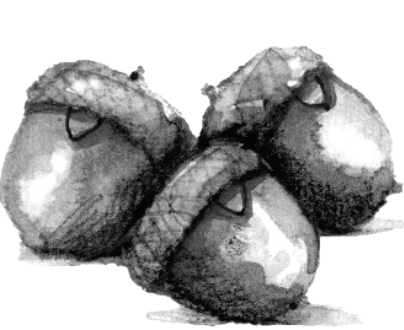In northern New England, acorns ripen in late summer and normally drop from oak trees from September through October. They may fall earlier, however, for a host of reasons, from eager squirrels getting a head start on gathering nuts for the winter to environmental stress, including excessively hot or rainy weather. Prematurely dropped acorns are green, whereas ripe acorns are brown. Other reasons acorns may drop early include poor pollination and tree infestation by insects or diseases. The most peculiar cause of premature acorn drop that I have encountered is the acorn pip gall wasp.
Native where oaks are present, this cryptic wasp goes mostly unnoticed. That is, unless your favorite summer shade tree happens to be an oak, and that tree starts dropping acorns on your head in August. You may also notice black sooty mold growing on your deck or outdoor furniture, and small, hard, cream-colored, triangular-shaped objects which resemble teeth under your oak trees. These are all signs you are experiencing an outbreak of the acorn pip gall wasp (Callirhytis operator).
Gall wasps, which belong to the family Cynipidae, do not sting. There are more than 700 species of cynipid gall wasps in North America and at least 90 species within the genus Callirhytis. Their feeding creates galls plant tissue overgrowth on leaves, twigs, flowers, and fruit. The galls protect the wasps from predators and provide a food source for developing larvae. There are several noticeable Callirhytis species affecting oak in the Northeast. The wool sower gall (Callirhytis seminator) and oak wart gall wasp (Callirhytis quercusfutilis) only cause cosmetic damage to leaves. Gouty oak gall (Callirhytis quercuspunctata) and horned oak galls (Callirhytis cornigera) produce galls on twigs that can lead to branch dieback, but they typically do not cause tree mortality.
The acorn pip gall wasp, like other gall wasps, is tiny (2 to 3mm) and has a complex life cycle which takes two years to complete and comprises two alternating generations. The first generation is asexual (all female) and lays its eggs on oak flowers in spring. The feeding of the hatched larvae results in a woolly mass, or gall, on the catkins, and this generation is known as the woolly catkin gall or woolly blossom gall. Larvae feed and develop within this gall and emerge as adult males and females in June.
The second generation (sexual generation) including males and females, mate and lay eggs on developing acorns from late summer through fall. The feeding of these larvae causes a triangular shaped gall to form just below the acorn cap. The larvae reside and feed in the gall which signals the tree to release the unviable acorn. The gall eventually falls out of the acorn — leaving tooth-shaped debris – and the larvae completes its development over the next 20 months on the ground.
Oak species affected by the acorn pip gall wasp include red, white, black, scarlet, and scrub oaks. The damage to the acorns makes them incapable of producing seedlings, but the wasp larvae provide an extra treat for squirrels and other animals who eat acorns. When affected acorns separate from the tree, the sugary sap drips from the separation point on the branches. This promotes the growth of sooty mold, a sooty fungus that can that can make the surfaces of whatever the sap drips onto sticky and slippery. Sooty mold is not harmful but is unsightly; you can remove it using soap and water.
Control of pip gall wasp is not warranted as it does not harm the trees and the larvae are beneficial as a protein source for animals that consume acorns. Additionally, outbreaks are rare and short lived. The last widespread outbreak of acorn pip gall wasp reported in the Northeast occurred in 2019. However, I have noticed another outbreak in my oaks in New Hampshire this year. If you pick up an acorn, you too may find this elusive wasp.
Jen Weimer is a forest health expert, photographer, and writer living in the forests of New Hampshire. Illustration by Adelaide Murphy Tyrol. The Outside Story is assigned and edited by Northern Woodlands magazine and sponsored by the Wellborn Ecology Fund of the New Hampshire Charitable Foundation: nhcf.org.




